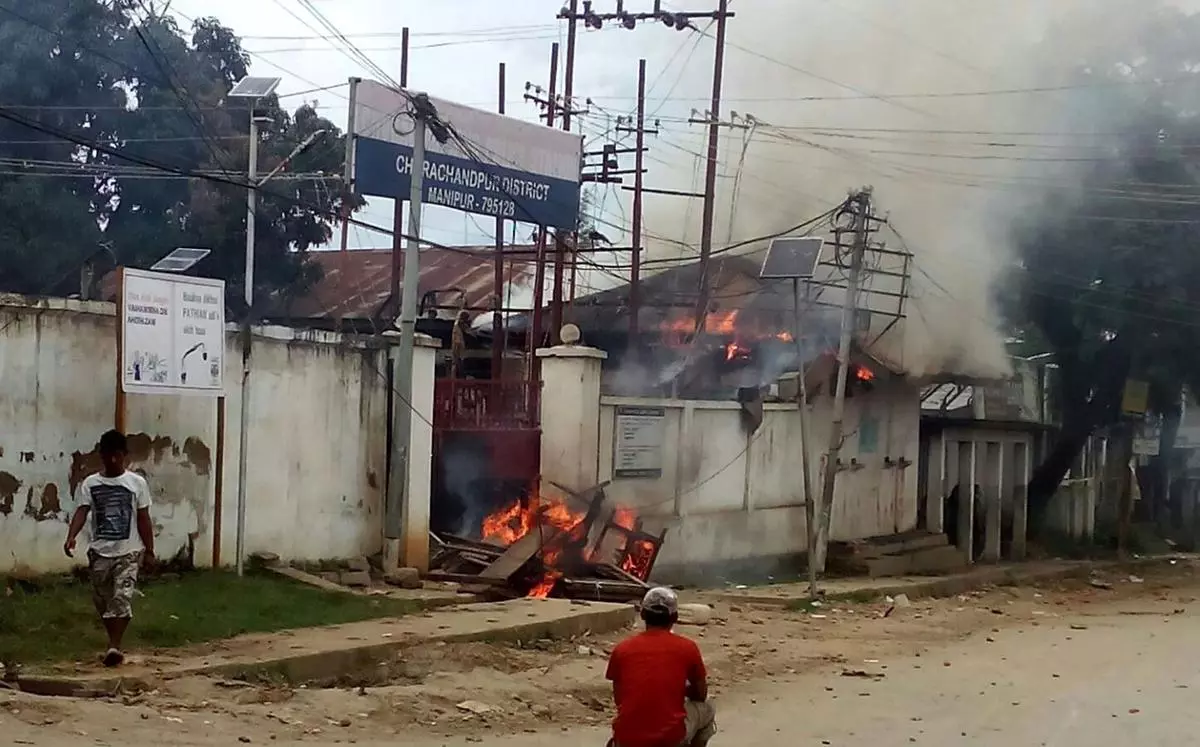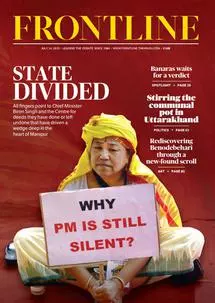Targeting of Kukis the main reason behind Manipur violence
The government’s persistent dismissal of Kuki grievances, coupled with its longstanding efforts to label them as outsiders, has led to the crisis.
Published : Jun 27, 2023 17:40 IST - 13 MINS READ

Kuki people stage a peaceful rally to restore peace in Manipur during the visit of Union Home Minister Amit Shah in Churachandpur on May 30. | Photo Credit: ANI
Since early May, when an intense wave of violence and ethnic strife convulsed Manipur, everyone has said practically everything about the north-eastern State. There is a frenzied rush to identify the immediate triggers of the violence. But few have spent time discussing its broader context.
There is a mistaken belief among large sections of the mainstream policy and media community outside Manipur that this is a petty brawl between two ethnic groups in the “remote north-east” that can be resolved only if both sides make some concessions. This liberal imagination ignores the gross imbalance of social and political power between the Meitei and Kuki—specifically, how the former enjoys greater agency in decision-making and discourse-setting processes over the latter.
The dominant media outside Manipur has also failed to sustain the focus on how the N. Biren Singh government and Meitei civil society deployed problematic tropes to other-ise the Kukis who have lived in Manipur for many centuries. It has also avoided an honest discussion on how the government dismissed serious Kuki grievances for years, allowing their discontent to reach boiling point. Instead, the media continues to obsess over guns and drugs, as if all of Manipur’s problems would disappear if one removes these two from the equation.
Current Issue
Also Read | Mayhem in Manipur: The State burns while the Centre looks away
Sure, a lot of what is going on in Manipur is to do with M16 assault rifles and poppy. Two phrases currently in circulation amongst conflict intellectuals are “sophisticated weapons” and “narco-terrorists”. But these are just the outer shells of a conflict whose roots lie elsewhere. Thus, there is a need to recentre the debate on Manipur. We can start doing that by placing the events leading up to the current wave of violence in the right context.
No effort at dialogue
There is a certain view amongst mainstream commentators that the Manipur violence was triggered by a single event—the Manipur High Court’s April 19 order to grant Scheduled Tribe (ST) status to the majority Meitei community. That is not entirely the case. In the months leading up to the order, a series of brash policy decisions and divisive political iterations had already soured the atmosphere and frayed the delicate social contract of Manipur.
On March 10, the Kuki civil society, led by the Indigenous Tribal Leaders’ Forum (ITLF), organised a peaceful rally in several hill districts, including Churachandpur, Tengnoupal, Kangpokpi, Ukhrul, and Jiribam. It was a State-wide, non-violent agitation against the Biren Singh government’s policy of arbitrarily evicting Kuki villages under the garb of expanding reserved forests—a move that many community voices argued was in violation of The Indian Forest Act, 1927, and Forest Rights Act, 2006. They were particularly protesting the forced eviction of some 16 Kuki families from the tiny village of K. Songjang, located in Churachandpur district, on February 20. One such rally in Kangpokpi turned violent when the local police used force on the protesters, reportedly injuring 20.
“Over the last few years, the Biren Singh government has pushed Manipur’s delicate ethno-political consensus closer to the cliff-edge by steamrolling policy initiatives without wider consultations to create an insider-outsider divide.”
But, instead of inviting the protesters for a dialogue and making a proactive effort to de-escalate tensions, like any impartial government should do in such cases, the Biren Singh administration dialled up the heat. First, it imposed prohibitory orders under Section 144 of the Code of Criminal Procedure in the hill districts. Then, in the late hours of March 10, it withdrew from the Suspension of Operations (SoO) agreement with two Kuki armed groups—the Kuki National Army (KNA) and Zomi Revolutionary Army (ZRA). To a lay observer, it might have seemed like the State government was conflating two different issues. But it was a deliberate move designed to discredit the protests.
By revoking the SoO pact, the Singh government did two things at once: it walked out of the tripartite peace process between Imphal, New Delhi, and the Kuki armed groups, and it told the people of Manipur that the Kuki protests were directly linked to militant groups. This was an absurd and precipitous response to what was essentially a civil society rally. The Chief Minister even went to a news channel from the north-east and blamed “illegal immigrants from Myanmar” who are “doing poppy plantations and drug business” for the protests. He linked the rallies to the KNA and ZRA, making sure to highlight that the ZRA was led by an ex-MP from Myanmar and the KNA by a “Haokip from Nagaland” (Haokip is a common Kuki clan name).
Drumming up fear
Imphal’s message was clear, although wholly unsubstantiated and deeply troubling—the unrest in the hills was remote-controlled from beyond Manipur’s and even India’s borders. This despite the Kuki leaders who organised the March 10 rallies—such as the ITLF Secretary, Muan Tombing—publicly distancing themselves from political parties and armed groups. They insisted that theirs was a purely civil society-led movement meant to vocalise the genuine and organic discontents amongst Manipuri Kukis.
In fact, one day after Chief Minister Singh gave his provocative interview, Seilin Haokip, spokesperson for the Kuki National Organisation (KNO), a coalition group of 17 Kuki SoO groups, went to the same channel and confessed that the ITLF had asked his group to stay away from the protests.
“Both communities, the Meiteis and the Kukis, are now bound together by a shared sense of existential insecurity. This, in turn, is creating endless cycles of violence today.”
For anyone closely following the recent pathologies of Manipuri politics, the Imphal government’s dismissal of Kuki grievances by using the fig leaves of militancy, illegal immigration, and poppy cultivation would certainly not have come as a surprise. Over the last few years, especially since it returned to power in 2022, the Biren Singh government has pushed Manipur’s delicate ethno-political consensus closer to the cliff-edge by steamrolling policy initiatives without wider consultations and deploying a bewildering mishmash of issues to create an insider-outsider divide.
First, the Biren Singh government has liberally used the influx of Chin-Kuki asylum seekers fleeing brutal attacks by the junta in Myanmar, which attempted to snatch power from an elected government in February 2021 through a coup d’état, to reanimate Meitei nationalism and give it an antagonistic edge. It did so by using a classic ethno-majoritarian tactic: amplifying a pre-existing fear psychosis amongst the Meiteis that they would soon be overrun by Kuki “illegals” from Myanmar.
Driving a wedge
The Chief Minister, who should have been a force for inter-ethnic unity and fraternity in fragile times, has himself used pejoratives to drive a wedge between the two communities. For instance, in April, he told the RSS mouthpiece, Organiser, that “‘foreigner Kuki’ immigrants have taken control of the social, political and economic affairs of the native tribal people of the state”, which has reduced the “indigenous people of the state to second-class citizens”—an assertion that has little to no quantitative or qualitative basis. In fact, he had himself asserted at a media conclave just five years ago that there were no “illegal infiltrators” in Manipur.

A burning police station in Churachandpur district of Manipur on September 1, 2015. Hundreds of protesters clashed with the police over the passing of three controversial tribal rights bills, which were seen as means of appeasing the Meitei population, who were demanding an “Inner Line Permit” to restrict and regulate the entry of “outsiders” (Indians included) into Manipur. | Photo Credit: AFP
But it is not just about stray verbal iterations. The Singh government has also exuded a sense of action to bolster its politics of indigenity. Responding to the demands of Meitei civil society, it has expressed willingness to introduce an Assam-like National Register of Citizens (NRC) to sieve out “illegal immigrants” from Manipur’s population. Much like how the Assam NRC disproportionately victimised Bengal-origin Muslims by questioning their Indian-ness, a similar exercise in Manipur would likely put the Kukis, many of whom have intergenerational links with Myanmar and do not possess formal documentation (like birth certificates and land ownership deeds), on the short end.
Also Read | Manipur reinforces importance of governance over litigation for lasting solutions
As Sangmuan Hangsing and Tawna Valte highlighted in a recent piece for East Mojo, the State government, earlier this year, launched “verification drives” in the Kuki-dominated hill districts to identify “illegal immigrants” from Myanmar by collecting individuals’ biometric details. This, they argue, unjustly infringed upon the privacy of Kuki families. Notably, these verification drives were undertaken without any proper legal mandate. The NRC in Assam, notwithstanding its segregationist design, was sanctioned by the Supreme Court.
Singh has also indicated that his government would start conducting “house-to-house surveys” to identify illegal immigrants. It has already detained at least a hundred asylum seekers from Myanmar since January from the hill districts bordering Myanmar, such as Churachandpur and Tengnoupal. Even as all of this was going on, in February, Singh announced that his government would set up 34 new police posts along the India-Myanmar border to “check cross-border infiltration”. Meanwhile, the Central government, with Imphal’s cooperation, has been erecting barbed wire fences along the border.
Highlights
- The N. Biren Singh government dismissed serious Kuki grievances for years, allowing their discontent to reach boiling point.
- Over the years, the Biren Singh government has liberally used the influx of Chin-Kuki asylum seekers fleeing Myanmar to reanimate Meitei nationalism and give it an antagonistic edge.
- By flattening Kuki villages in the name of environmental protection, instead of working with the community, the Imphal government projected the tribal community as one that is not interested in saving the environment.
Soft border
In effect, the Singh government has attempted to harden a border that was always fundamentally soft in character. It is this “softness” of the India-Myanmar border running along a 1,640-kilometre multi-ethnic stretch of India’s north-easternmost edges that makes it more than a drab political boundary—it is a living thing that breathes life into an otherwise hostile and remote administrative frontier. The reality of various ethnic communities moving across this border for both mundane and extraordinary reasons is a historical truism that no local or Central government has ever been able to permanently mediate. Singh, as a Manipuri Meitei, likely knows this well, but is willing to militarise and exceptionalise the border areas for ethno-political ends.
Manipur police personnel guard a Kuki village to prevent further violence during the curfew in Churachandpur district of Manipur on May 17, 2023. The army and paramilitary forces were called in to for peace-keeping in the district. | Photo Credit: RITU RAJ KONWAR
Ultimately, none of Singh’s executive decisions may sustain as envisioned, but few can deny they have done enough to foment a sense of demographic alarmism and existential precariousness amongst the Meiteis. Many of them now believe that their homeland is under some kind of “external aggression”, to borrow a phrase used by State institutions and ethno-nationalist civil society in Assam with troubling frequency. Ironically, this securitised state of exception has come at the cost of the Kukis’ sense of security and belongingness in a State that they too consider home. This has produced an odd, somewhat paradoxical, outcome—both communities, the Meiteis and the Kukis, are now bound together by a shared sense of existential insecurity. This, in turn, is creating endless cycles of violence today.
Second, by using land surveys to expand the limits of reserve forests across the hills, arbitrarily bulldozing Kuki settlements, and displacing villagers without proper compensation or rehabilitation, the Manipur government has created a feeling of rootlessness and alienation in the collective Kuki psyche. The community’s leaders argue that many of the evicted villages have existed for more than half a century, and see the government’s expansion into their ancestral land as “encroachment”.
The government counter-argues that it is the Kuki who is encroaching on protected forest land. “They are encroaching everywhere,” said the Chief Minister in an emphatic telephonic interview with veteran Assamese journalist, Wasbir Hussain, on March 10 as Kukis took to the streets. In hindsight, this follows linearly from what Singh said two years ago in Kangpokpi district’s Mangjol village, ironically, during a “Van Mahotsav” (or “forest festival”): “All lands belong to the state.”
False portrayal
Binary disagreements aside, the moot issue here is of consultation, or lack thereof, with stakeholders. The reserved forest issue would have probably been resolved amicably if the State government had discussed it with the Kuki community and civil society leaders, to make them feel they are an active part of the policymaking process. Those like the Kuki Students’ Organisation (KSO) had been peacefully voicing their grievances over the reserve forest expansion, such as in the case of the Churachandpur-Khoupum Protected Forest, since 2022. But the State government did not invite them for formal consultations.
A labourer from Myanmar carries sacks filled with charcoal for sale in the Indian border town of Moreh in Manipur in February 2012. The India-Myanmar border is than a drab political boundary—it is a living thing that breathes life into an otherwise hostile and remote administrative frontier. | Photo Credit: RUPAK DE CHOWDHURI/ REUTERS
Environmental protection must go hand-in-hand with the protection of vulnerable communities who are most affected by environmental degradation—the Kukis, in this case. Community consultations become even more crucial when land that a modern state wants to regularise is governed by longstanding customary laws and norms of village settlement. By flattening Kuki villages instead of working with the community, the Imphal government ended up projecting the tribal community as one that is not interested in environmental protection and only understands the language of force.
This is hardly the case. All that the Kuki civil society had been demanding, as reflected in a KSO memorandum from November 2022, was for the State government to conduct proper inquiries into the extent of the State’s rights over forest land by virtue of The Indian Forest Act, 1927 before taking any brash action (like evictions). That never happened.
Also Read | Editor’s Note: Militarised Manipur stares at a civil war
The State government, by sidelining the very community that has been living on forest land for decades, if not centuries, only widened the mental distance between the Imphal valley and the Kuki-inhabited hills. By repeatedly disparaging the Kukis as encroachers and outsiders, further, it validated the belief that a new geographical imagination of Manipur, which has no place for the Kukis, was in the works. This is the same government that had promoted initiatives such as the “go to hills” campaign some years ago to bridge the hill-valley divide.
The perceived loss of political agency amongst the hill-inhabiting Kukis is not new. In fact, it is not even limited to the Kukis. In 2021, the Hill Areas Committee (HAC), a body of 18 Naga, Kuki, and other tribal legislators from the hill districts of Manipur, proposed what was known as the “Autonomous District Councils (ADC) Amendment Bill 2021”. The proposed law was meant to give the HAC more autonomy in economic and administrative affairs. However, the Singh government continued to stall it and ultimately, introduced two alternatives that, according to the hill tribal leaders, diluted the original Bill. Agitations and blockades followed, but no logical conclusion was reached.
Pending issues such as these have contributed immensely to widening the hill-valley divide, driving the Kukis out of Imphal’s orbit, and finally, creating conditions for violent unrest. They are more central to understanding the current violence than guns and drugs.
Way ahead
Contrary to what many believe, reconciliation is different from peace-making. The former demands a genuine collective desire to put things behind and move on in a way that is just and acceptable to all. The latter is often an interim absence of violence without equitable guarantees and a sense of justice. We might soon see peace return to Manipur, but reconciliation will take time.
Also Read | What is really behind the violence in Manipur?
What Manipur is going through today is no ordinary instance of mass violence. It has, as Arunabh Saikia recently observed in an online article after a reporting trip to Manipur, partitioned the State in “arguably unprecedented” ways. Indeed, Manipur seems to be undergoing a kind of turbulent transformation, a radical remapping of its political geography, that will take years, if not decades, to undo.
Graffiti by Kukis demanding land rights at Churachandpur district of Manipur on May 17, 2023 | Photo Credit: RITU RAJ KONWAR
To move forward, a strife-torn society first needs to look back briefly. For genuine reconciliation to happen, there needs to be an honest recognition of some facts: one, this was never an equal clash between two equal sides; two, the Kuki community was consistently ignored, other-ised, and berated by the State government and Imphal-based civil society over angular issues like drugs, illegal immigration and encroachment; and three, the State government abjectly failed to protect vulnerable sections of the population in Manipur from majoritarian violence.
If mainstream society in the State and the government recognise these facts of their own volition, durable peace may come to Manipur sooner than expected. If they do not, Manipur, which was once presented as India’s gateway to Myanmar and Southeast Asia, could be in pain for a long time.
Angshuman Choudhury is Associate Fellow, Centre for Policy Research, New Delhi.
















COMMENTS
READ LATER